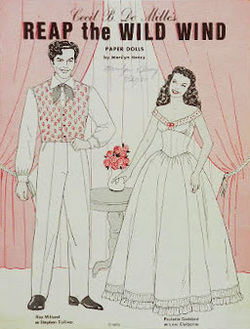
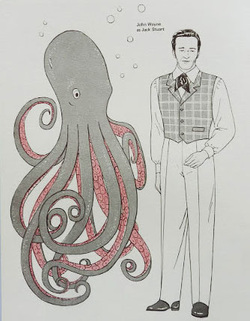
There are four pages of clothing in the set, but I only have some rough images of two of the four (below).
The usual apologies for my absence lately. I hope to maybe post something new of my own soon.
| 19th Century Paper Dolls |
|
 Reap the Wild Wind was an 1942 action flick starring Ray Milland and Paulette Goddard (with a young John Wayne and Susan Hayward!). It's basically a romance about Clipper salvage in Key West the 1840s (an interesting and unusual subject!). In 1973, Marilyn Henry created this lovely paper doll set based on the film. I came across this on eBay and would love to bid on it, but I am sure it will go too dear for what I would be willing to pay. It's a nice set of the sort that you could color yourself (color printing was just too expensive 40 years ago unless you were a big publisher). It nonetheless has a spot color cover (presumably heavier stock), so the characters have some tints.  My absolute favorite is the inclusion of the octopus (definitely a stand-out character in the film). The film, of course is rather silly and the costumes are not especially period-appropriate (this was a low-budget film made during WWII, which adds to its overall "cheap" look and feel ~ but hey, they did pretty good with what they had! There are four pages of clothing in the set, but I only have some rough images of two of the four (below). The usual apologies for my absence lately. I hope to maybe post something new of my own soon. Totally awesome 1841 set of paper dolls on auction through Theriault's. Described as "very rare" with a title: Mythologie Pour La Jeunesse. This set was made in Vienna by H.F. Muller. It includes two dolls (male and female), and 14 stunning costumes representing various Greek and Roman deities. The auction site describes the folio as beautifully marbled with applique on the "mythologie" scroll. This set was intended to be fun and educational and came with a "72 page book, written in both German and French, detailing the writer's purpose: to teach mythology to his children by means of paper dolls with changeable costumes that represent the features of various Greek or Roman Gods."
Don't know how much something like this will go for at auction, but it being such a lovely complete set in such nice condition, I'm sure it will go dear! Amazing colors! Wish we could better see the male doll ~ his little head is peeking out above the short yellow toga roughly in the middle at the bottom. Click the image to see more detail! 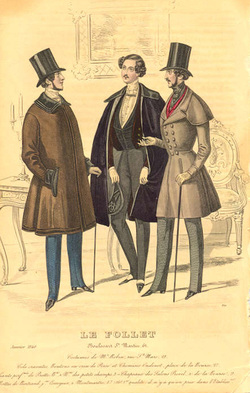 Just some random lovely fashion plates today (want to keep things going here, though still no sign of me getting any closer to acquiring a new scanner). In the meantime, enjoy these lovelies. While I don't know the original source of the one down below (found it randomly on an internet search, the one posted here to the left is from the magazine Le Folliet from The Costumer's Manifesto (a site with some nice fashion plates!). I chose both of these because they show some fashionable men's clothing (which by now you all must know I am a bit obsessive about). Not that I don't love women's clothing as well. I just think men's fashions from the 19th century are equally fascinating and more interesting than generally represented. Both of these plates show men in the wide-skirted long frocks of the 1840s-50s, with colorful vests and contrasting trousers (usually of a pale color like dun, dove, or gray). Cravats and lapels were wide, while waists were narrow. It was during the 60s that men's corsets fell out of fashion as the popular silhouette became less waspish. Small feet have always been considered beautiful and like most fashion plates, here are a bunch of people trotting about on tiny little pointed shoes. Men's footwear, in reality, was a bit less extreme than what is depicted here 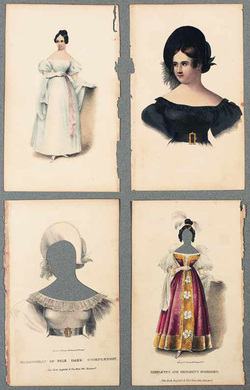 I've been caught up in other things and neglecting this blog horrifically. Part of it was just my annoyance at all the spam (and thinking to move to another platform), but things have quieted down lately and I want to try to recommit some effort here! So you don't care about what rabbit hole I have been down, let's look at some cool pictures! Today I have a handful of auctioned dolls found while browsing Theriault's (a great site for pictures of these sorts of things!). The first is an unusual set of "overlay" dolls (where a cutout image is placed on top of the figure in order to "dress" it). The description on this one reads, in part: "one illustrates the 'management of pale/dark complexion' by showing judicious use of proper costume colors, and the other, a full-figure model, with die-cut face, compares 'simplicity and ornament' in costume." A fun an interesting reminder that many of these early paper dolls were not just considered playthings, but were ascribed an educational and practical value for women navigating a society full of very particular expectations. These are American and marked as being produced by Scofield & Voorhees. By the styles, they were made in the early 1840s. 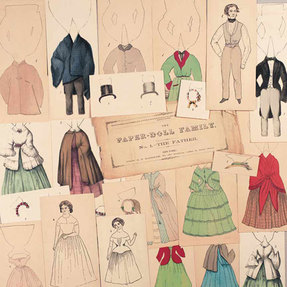 The second image is also unsual and one that I had never seen before: The Paper Doll Family (circa 1857). This was apparently a set in which the family members were packaged and sold individually (I love the envelopes!). Also, notice that the clothes are designed in the style of having a "ghost" back to hold them in place (and are not two-sided as was typical of the fancier models of the era). The lack of a back made these cheaper and faster to produce. Unlike the overlays above, these were definitely playthings for children. The description on the site says: "Comprising the complete seven piece family set (Father, Mother, Miss Adelaide, Clara, George, The Baby, Bridget the Nurse), each in its own envelope along with complete uncut set of double-sided colored costumes, along with matching uncolored costumes designed for child play. Sizes vary, father is largest at 6.5". Also included is advertising flyer for The Family, and envelope wrap for "Paper Dolls Furniture" with price lists and 8 small furniture accessories." Fun! These were produced by Anson Randolph. And finally, below is a collection of German paper dolls produced by Mainz bei Josef Scholz (circa 1850s). This is a hodgepodge of mostly dolls of children. I love their tiny feet and little boots! Click on any of the images in this post to better see some of the details on these lovely very old dolls! 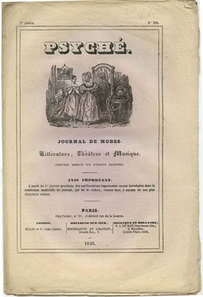 I meant to post a nice fashion plate yesterday for Fashion Plate Friday (was hoping to get that going again), but yesterday turned out to be rather busy, so I blew it. But I won't let the weekend go without posting something (because, surprise surprise, I am still working on the dolls and don't know when I will finish ~ and don't want to make any more promises that I can't keep! But anyway, I still missed Fashion Plate Friday, so I present you, instead, an antique paper doll from a series recently selling on eBay (a.k.a. the devil). The seller of these dolls has been posting them one at a time and each has been selling for upwards of $150-$200. I can see why for the real collector: they are absolutely gorgeous. Pysche was a popular French ladies' magazine and produced quite a few paper dolls during the 1830s and 1840s. If you look at posts under the category Antique, you may find others. One of the characteristics of many Victorian paper dolls is that they were double-sided. Or rather, they were built to be viewed from the front and the back. This required a level of artistry on the illustrators and it also required careful assembly on the part of those who cut them out and played with them. The double-sided image was important to girls and dressmakers throughout the century: fashions were made to be as equally pleasing from the back as they were from the front. This was especially true of the bustle era. For this doll, the hat is a separate two-sided article as well. Click on the image below to see a little bit better detail. Although there are a number of these dolls that have been posted for sale, I chose this one because it's a very cold morning (about 20 degrees), and the winter ermine looks nice and cozy. Also, the date of the doll and the current date were nicely close. 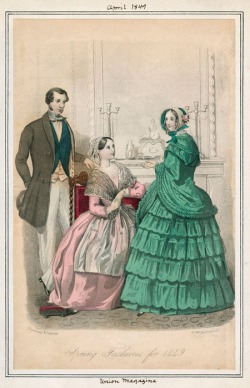 Today I am sharing a beautiful fashion plate from Union Magazine, April 1849. The inclusion of the man in this image is lovely since around about the 1860s men sort of drop out of the fashion plate world in women's magazines. Later they emerge again in their own books, but the ladies magazines will be inclined to focus on women and sometimes children more exclusively. I don't know much about Union Magazine specifically. There were many flash in the pan publications around this era when publishers realized that ~ wow ~ based on the success of Godey's, it was apparent that women liked to read! And so the market was full of magazines to appeal to women mostly of a privileged class, though cheaper books were likewise produced in an attempt to appeal to women of lower means as well. The glut would eventually lead to a magazine Darwinism, with the strong rising to the top and the weaker falling away. Godey's would likewise continue to dominate despite competition from Demorest's magazine, and would only eventually succomb to the popular format of Harper's Bazaar. 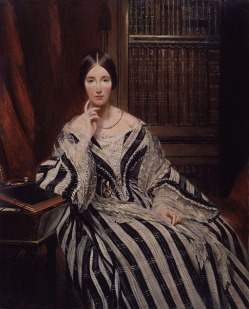 The painting is of Angela Georgina Burdett-Coutts Angela was, in 1837, the wealthiest woman in England. You can read more about her at the above link, but you might like to know that in contrast to some heiresses today, she used her immense fortune toward charity, for the most part. She also, at an advanced age, "shocked polite society" by marrying her young secretary who was 40 years her junior. The painting, done in the 1840s, shows her as a young woman in a beautiful gown (click on the picture to see larger). She kinda looks like Dolly Madison on the doughnut and cookies boxes (for those of you who remember the old advertisements). ALSO: As promised, on Halloween (tomorrow) I am kicking off a new paper doll blog based on a couple of favorite comic book series of mine. The initial dolls are finished and posted already. You can set a new bookmark to: Comic Book Chronicles to join the fun! 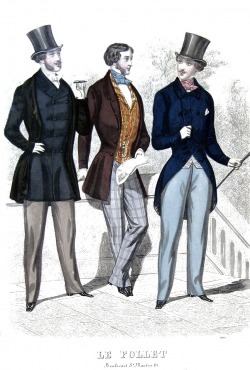 I did actually work on some original designs this weekend, but they are still in the pencil stage. I don't know why I get so perfectionist about this stuff. I am hoping, once I get back from San Diego (next Tuesday), I will find a way to streamline this process so that I will just move from design to drawing to painting without all of this fretting in between. I half-considered just rendering the clothes in sepia since I know it would be so much easier. It's the whole color thing that's holding me back. Color paralyzes me. I don't know why I don't just get rid of it and do monochromatic work instead. Then, if people want to color the clothes, they can do so themselves. I am trapped somewhere between going in this direction and fighting the good fight to not let the color thing beat me. While I duke it out psychologically, do enjoy this fashion plate from Le Follet (1849). Men's clothes were certainly more interesting in the first part of the Victorian Era (I love the long vests and the fabulous trims). They got a lot more maudlin as the century wore on: mostly black and neutral colors. styles in America prior to the Civil War generally seemed a lot dandier. We wouldn't see a lot of color back in men's clothes until the 20th century, alas. Likewise, enjoy this blog by Dorothy Jane Landgren Williams, which posts fashion-related items (including plates) from time to time. While the focus is mostly Regency-Era stuff, there's lots of other fun things to look at as well: Paraphernalia. I will return next week (and once again, hopefully more often). 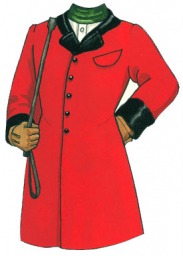 I have been meaning to update for some time (always excuses, I know), but it's been a juggle working on other web-related projects. I am officially caught up, however, and so can devote a moment to some small bit of proof that I am working on the dolls that I had begun when I started this blog. 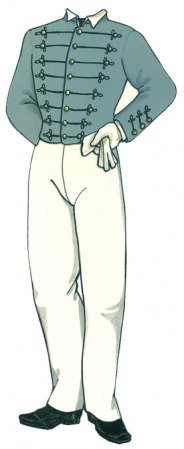 I also finished his West Point Academy cadet's uniform. This is two separate pieces, which is nice because then he can wear those white pantaloons with other coats, etc. And while I personally have a horror of white trousers, I do not doubt for a moment that James would have worn them and fancied them (as well as ones in "buff"). I've never thought of James as someone who would care for the dreary black suits that would dominate the latter half of the century. 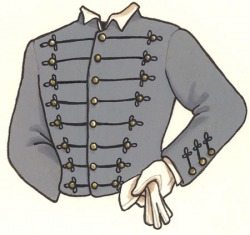 I promised myself I would post at least one piece of clothing this week, so as to keep motivated as far as painting is concerned. I started working on a very simple vest for James, then got distracted into making this West Point Military Academy jacket. James entered the Academy in 1844 and graduated second to the last in his class in 1847 for sheer want of discipline (just missing the honor of being the "goat"). 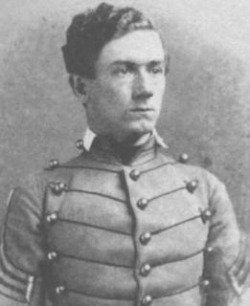 The only thing I might add are the buttons on the collar (you can see them here on the left from this example of the uniform from 1859). |
Paper Dolls Downloads
The download gallery has been closed indefinitely. You can still see posts related to each character by clicking their name in the list under "Categories" below. Categories
All
Archives
December 2012
|